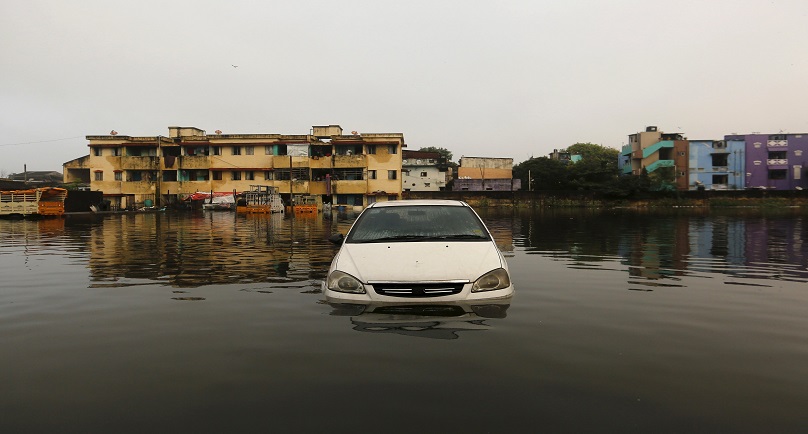Image: A car is seen in the flood waters at a neighbourhood in Chennai, India, December 4, 2015. REUTERS/Anindito Mukherjee
By Sanjeev Miglani
CHENNAI, India (Reuters) – Residents clutching babies and food packets thronged flooded streets in India’s Chennai on Friday, braving chest-deep water to reach higher ground or heading the other way to rescue relatives amid fears swollen lakes will spread more destruction.
After a lull from the heaviest rains in a century that have killed at least 280 people this week, another rain burst was forecast to hit the low-lying coastal city within hours. But officials said brimming lakes were the main concern.
“The rain is not a problem now, it is the overflowing river and 30 lakes that continue to flood four districts,” a senior home ministry official in New Delhi told Reuters.
V. Raghunathan, 60, a manager at an interior design company living in the south of the booming industrial and port city, complained about the lack of warning before floodgates were opened.
“The authorities didn’t give us adequate information about water being released from a nearby lake. Before we could take action. My car has sunk and I had to move to the first floor of my apartment.”
Military helicopters dropped food to residents stranded on rooftops in India’s fourth-largest city, previously known as Madras. On Friday, the defense ministry doubled to 4,000 the number of soldiers deployed to help the rescue effort.
But help was slow to reach many in the city of six million, known for its automobile industry and IT outsourcing, with some families seeking safety on flyovers. Waters were not receding in some of the hardest-hit areas. Drinking water and fuel were in short supply, officials said.
Rescue teams urged people to leave inundated regions. Only roofs in some villages remained visible. Where water had receded, masses of black mud and garbage piled up.
“We are sending technical experts and engineers who will find a solution to flush out all the flood water. It has to be drained out soon, but we don’t know how,” said the home ministry official, who was not authorized to speak on the record and asked not to be named.
SOILED RUPEES AND ID CARDS
Cut off without electricity and cellphones dead for lack of power and living with foul water lapping in their ground floor house for three days, police constable P. Krishnaraj loaded his wife and two teenage daughters in a cycle cart and walked behind in knee-deep water.
He was going to move in with a colleague whose home was dry.
People were on the move across the city on the Bay of Bengal – many like Krishnaraj trying to flee, others heading in the opposite direction, hiring cars and motorbikes to try to rescue families stuck in the flood waters after days of waiting.
The number of people on the Basion Bridge flyover was rising steadily, many of them slum-dwellers whose homes had been washed away. They sat in the open, some carrying little bundles of their prized possessions – soiled rupee notes and identity cards.
A small pick-up van arrived at the top of the flyover bearing water packets and biscuits and was immediately over-run by people desperate for relief.
Rajarwadi, who sold vegetables by the roadside, said she had managed to grab a packet of biscuits for her daughter. Now her plan was to move further away to catch the next volunteer food drop.
She hadn’t seen government officials come to offer help to people camped out on the busy flyover on Thursday even though it was in the middle of the city.
Jose Sebastian, the head of a local construction company, said the biggest worry for his volunteer group was areas where the water level was too high for them to deliver food.
“We feel rather helpless,” he said. “We have lots of food, we have volunteers ready to go, but we don’t have the boats.”
(Additional reporting by Sudarshan Varadhan in Bengaluru and Rupam Nair and Mayank Bhardwaj in New Delhi; Writing by Frank Jack Daniel; Editing by Nick Macfie)
Copyright 2015 Thomson Reuters. Click for Restrictions.


